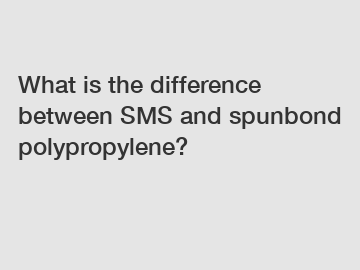Jan. 07, 2024
Health & Medical
For more information, please visit Huabao.
What is the difference between SMS and spunbond polypropylene?
SMS (Spunbond-Meltblown-Spunbond) and spunbond polypropylene are both nonwoven fabrics commonly used in various applications. However, there are distinct differences between the two.

Firstly, spunbond polypropylene is made through a process where polypropylene fibers are spun and then bonded together. This results in a fabric that is durable and has high tensile strength. On the other hand, SMS is a composite fabric that consists of three layers. The middle layer is made of meltblown polypropylene, which is created by melting and directing blowing polypropylene to form microfibers. These microfibers then form a nonwoven fabric by bonding with the surrounding spunbond layers. The presence of the meltblown layer in SMS gives it enhanced filtration properties.
The difference in fabrication processes gives SMS and spunbond polypropylene their unique characteristics and uses. Due to its three-layer structure, SMS offers improved barrier protection compared to spunbond polypropylene. It provides enhanced resistance against liquid splashes, droplets, and particulate matter. This makes SMS ideal for applications such as medical protective clothing, surgical drapes, and sterilization wraps.
Suggested reading:On the other hand, spunbond polypropylene is often used in applications where breathability and comfort are important. It is commonly found in products like diaper topsheets, hygiene products, and agricultural covers. The absence of the meltblown layer in spunbond polypropylene allows for better air permeability, making it more suitable for applications that involve direct contact with the skin or require adequate air circulation.
The difference between SMS and spunbond polypropylene has significant implications and impacts various industries. For instance, in the healthcare sector, SMS fabrics are essential for providing a high level of protection for medical professionals and patients during procedures. The enhanced filtration properties of SMS help in reducing the risk of cross-contamination and infection transmission. Additionally, SMS fabrics have found applications in the automotive industry for sound and thermal insulation purposes, as well as in the construction industry for geotextiles and erosion control.
By understanding the differences between SMS and spunbond polypropylene, manufacturers and consumers can make informed decisions regarding the selection of materials for their specific needs. With advancements in technology and continuous research, further improvements can be made in both fabrication processes, leading to the development of even more versatile nonwoven fabrics.
In conclusion, SMS and spunbond polypropylene are two distinct nonwoven fabrics with different fabrication processes and properties. Understanding their differences is crucial in selecting the appropriate material for specific applications, leading to improved performance and user satisfaction.
Please visit our website for more information on this topic.
Contact us to discuss your requirements of Type 5/6 Protective Coveralls. Our experienced sales team can help you identify the options that best suit your needs.
Suggested reading:Previous: How to choose a veterinary ultrasound machine?
Next: What is the difference between citicoline and citicoline sodium?
Related Articles
If you are interested in sending in a Guest Blogger Submission,welcome to write for us!
All Comments ( 0 )